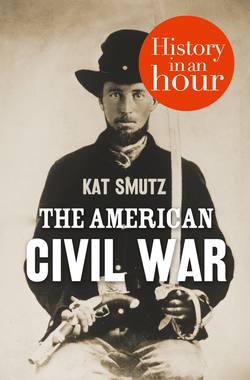Читать книгу The American Civil War: History in an Hour - Kat Smutz, Kat Smutz - Страница 10
ОглавлениеThe War at Sea
In spite of his limited experience of the military, Abraham Lincoln realized early in the war the importance of strategy and planning. He needed a plan of action to defeat the South and keep the states unified. Before his retirement, his general-in-chief, Brevet Lieutenant General Winfield Scott came up with a plan that was initially discarded by McClellan in favour of his own plan. But a series of moves on the part of the Union ended with the same results Scott had hoped for.
Scott’s basic concept was twofold. Firstly, Union ships would blockade Confederate harbours along the east coast. This would not only cut off trade and supplies, but would mean fewer lives lost than in a pitched battle. Secondly, Scott proposed sending troops down the Mississippi to capture key towns and take control of the river. It was this wrapping around and squeezing of the South that gave his strategy its name: the ‘Anaconda Plan’.
In order to blockade Southern ports, steam-powered vessels would be required. This presented a problem. The ships were fueled by coal, and would spend more time returning to port for refueling than they would guarding the Southern harbours. The solution was to find a port that the Union navy could take command of and where they could resupply their ships with coal.
USS Cairo on the Mississippi River
Two minor forts on the Outer Banks of Cape Hatteras, North Carolina were seized by the Union in August of 1861, and Port Royal, Virginia was taken in November of the same year. Port Royal became the base of operations for the blockade of Savannah, almost completely sealing it off. Union ships from Port Royal were also able to blockade Charleston Harbor, South Carolina, although not as effectively. To accomplish that would take one of the bloodiest engagements of the war.
Less than a year into the war, before Scott’s failing health forced him to step down, Major General George B. McClellan proposed a plan to Scott, who passed the idea along to Lincoln. It involved a direct assault on Richmond, Virginia, the Confederate capital. Many in the North supported such a plan, feeling that it would bring a swift end to the war.
But they were wrong. By attacking Richmond and moving on from there, the Union would be taking the South piecemeal. It gave Confederate forces opportunity to regroup, reinforce and resupply. The plan was also complicated by the Union sympathies in the western portion of Virginia that would later become West Virginia. The area was primarily pro-Union, with a ratio of seven Union supporters to one Secessionist. There was also the State of Kentucky which had declared itself neutral. McClellan’s march on Richmond would take him through these two areas and endanger the North’s good relations with states Lincoln was counting on to remain within the Union.
McClellan had begun to neglect the Mississippi River, leaving it as a back door of sorts for entering the South. But the navy hadn’t. On 24 April 1862, Captain (later Admiral) David Glasgow Farragut led his fleet up the mouth of the Mississippi River and took the city of New Orleans, Louisiana. He stopped only long enough to make repairs before steaming north and taking Baton Rouge, Louisiana, and Natchez, Mississippi.
A Union flotilla moving down the Mississippi River from the North had taken Memphis, Tennessee just before Farragut’s assault on New Orleans. That left only the city of Vicksburg, Mississippi, and a small fort at Port Hudson to hinder movement of Union ships. If they fell to Union occupation, the Mississippi River would be open from its source right the way to the Gulf of Mexico. It proved a much more difficult target than Farragut had anticipated. The town’s location atop high bluffs made bombardment futile. The city would stubbornly hold its position for more than a year until 4 July 1863, when it finally fell to Ulysses S. Grant, then commander of the Union forces in the west.
